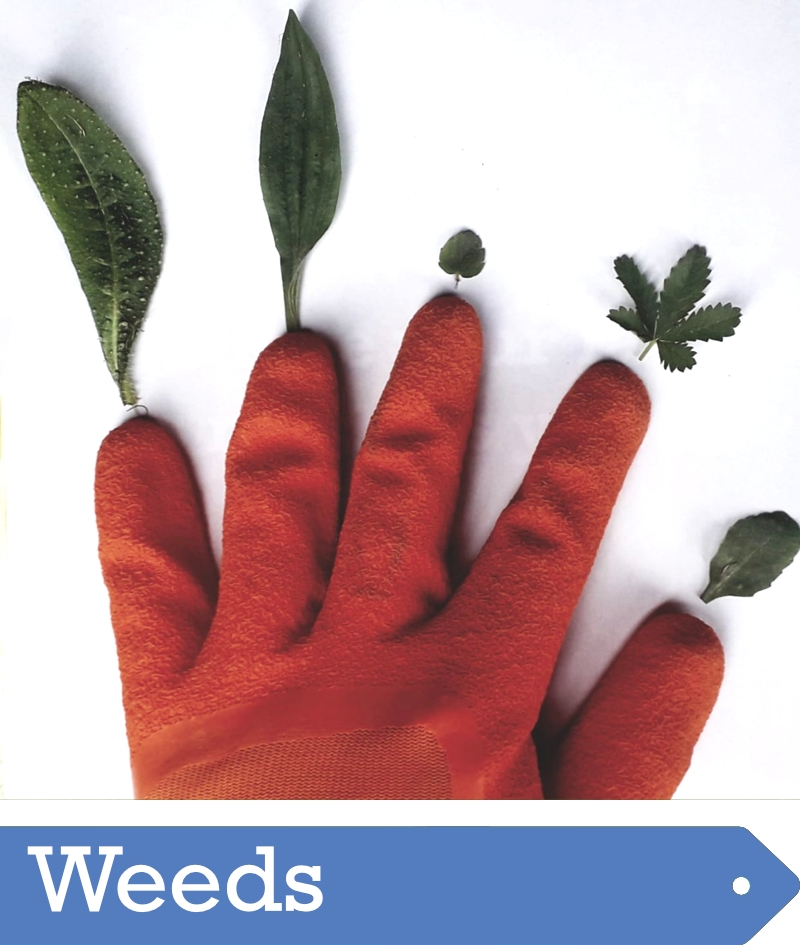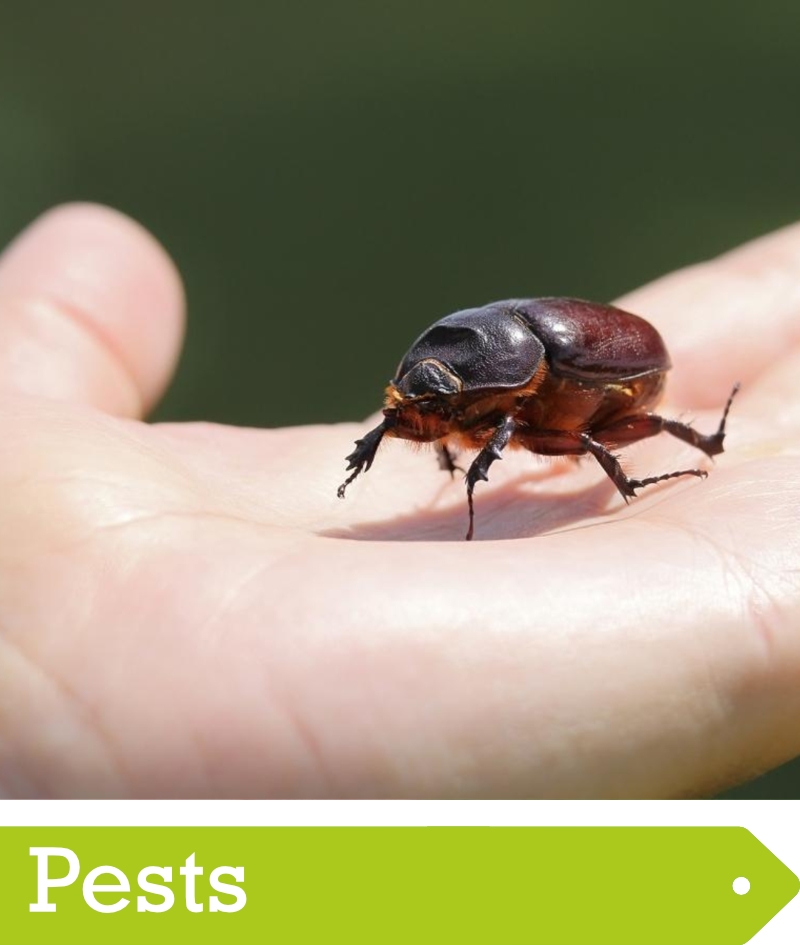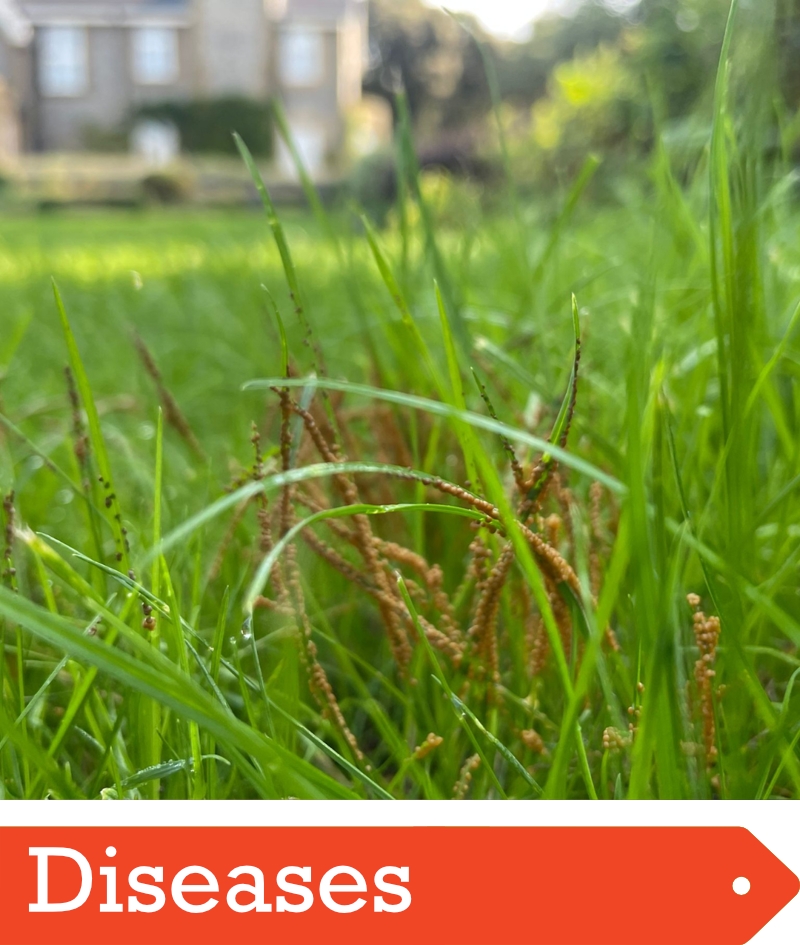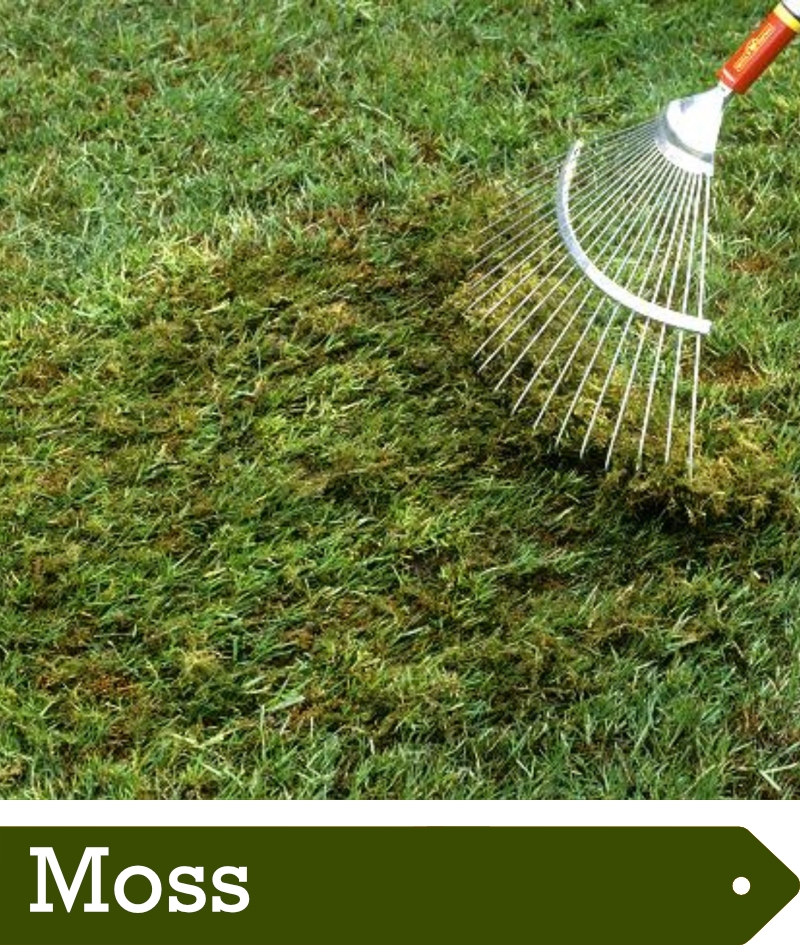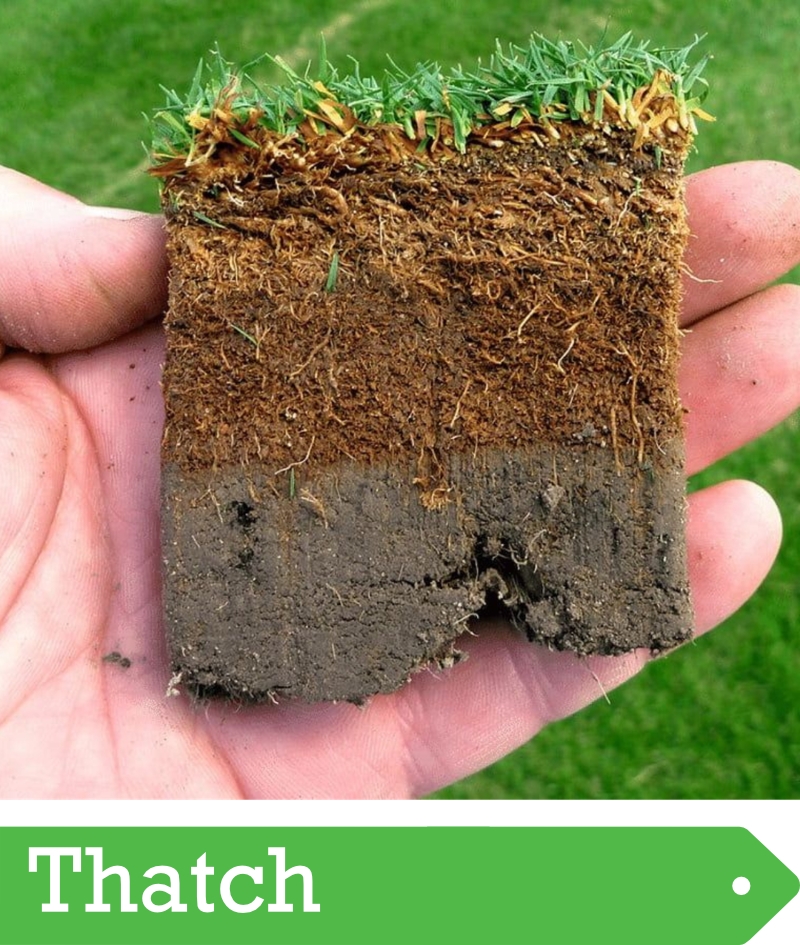Weeds are a common problem in gardens throughout the world
- Bristly Ox Tongue
- Buttercup
- Creeping Cinquefoil
- Daisy
- Dandelion
- Lesser Celandine
- MYOB
- Ragwort
- Ribwort Plantain
- Selfheal
- Speedwell
- White Clover
- Yarrow
If your lawn is not kept well fed and nourished then weeds will begin to develop. Joe’s always use the latest ‘state of the art’ fertilisers on the market to offer the correct balance of feed during the changing seasons. We treat your lawn with a non-scorch granular treatment for a greener lawn, and spray a range of selective herbicides to kill off any persistent problem weeds.
Keep scrolling down the page to learn more about the weeds that affect your lawn. Still unsure then Ask Joe!
Bristly Ox Tongue (Helminthotheca echioides)
This is similar to a dandelion, the leaves are long and have white pimples, it is rough to touch, digging up the root can be difficult due to the deep root system. It can be annual and biennial. You won’t find this type of weed in a well maintained garden but are likely to show up in neglected lawns and can grow in most soil types. Joe’s weed control can help take care of this stubborn problem weed.
Flowers: June to September
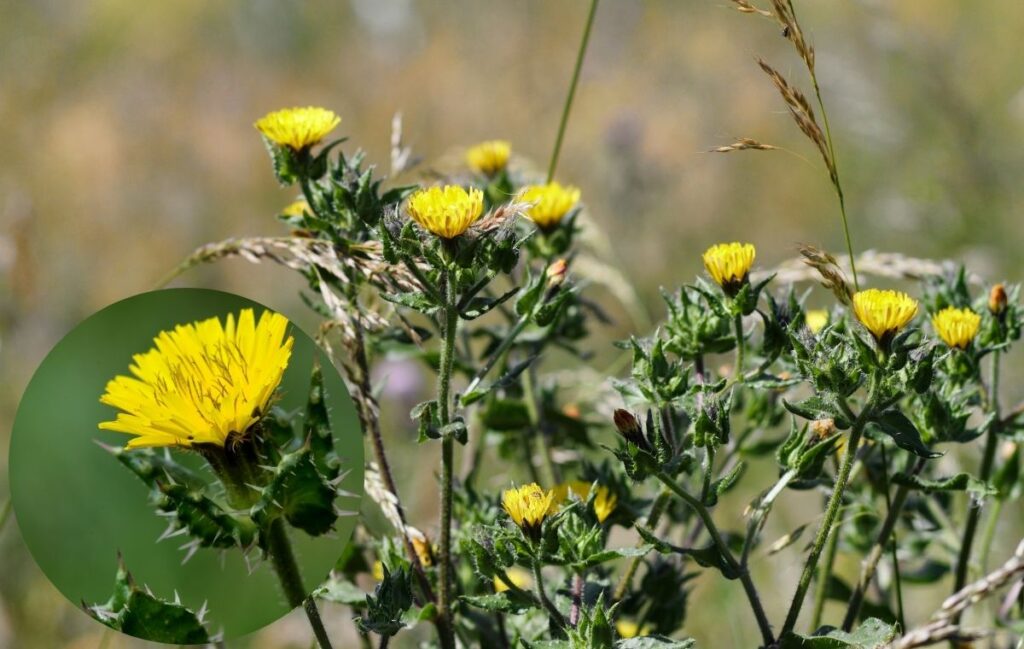
Buttercup
The bright yellow flower is hard to miss. These weeds will grow anywhere and spread quickly. The runners spread by rooting on along their way, it makes it particularly difficult to remove from the garden, but the best time to deal with it is when it is young and hasn’t had a chance to spread.
Creeping Cinquefoil (Potentilla reptans)
Bright yellow sunny flowers it really is very beautiful, however, they are invasive weeds and can soon become a nuisance in lawns, beds, and borders and can smother areas, they grow from a main taproot and runners are produced and root, they can easily take over an area up to 10sq metres per plant. They are strong-willed therefore making them a problem weed.
Seen through Spring – Autumn
Daisy AKA: Common daisy, lawn daisy or bruisewort
The daisy is a perennial weed and if not treated will come back year after year. The most common weed of them all, with white petals surrounding a yellow centre. In fact, we’re not even sure we had to include a photo but we did anyway. They spread with underground runners. They’re nice for the children to make daisy chains but picking from the stem bases unfortunately won’t get rid of them and they’re low growing plants which means they will tolerate close mowing making it particularly difficult to get rid of. Scarifying can help get rid of them and overseeding will help the grass be the more dominant plant when the turf grows back ensuring it is thick and healthy and regular weed controls can help keep the weed at bay.
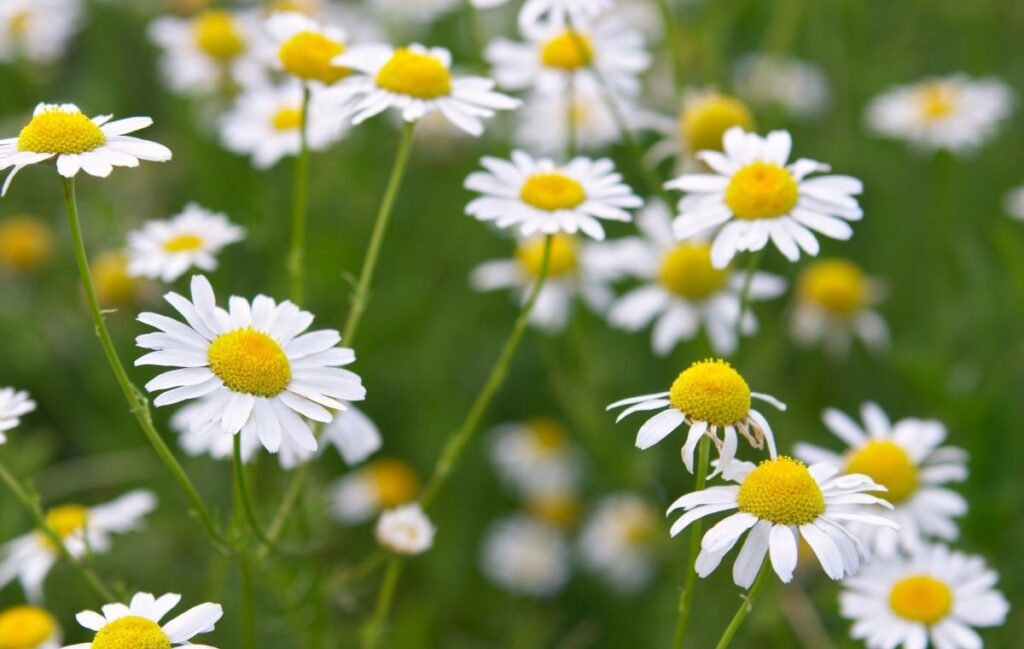
Dandelion
From French word ‘dent de lion’ meaning ‘lion’s tooth’ because of the shape of the leaves and the sharp-toothed edges. A very good weed for health benefits and is often used in medicines for infections and digestive symptoms. Even better the root can be used as a coffee substitute. They are a common perennial, love fine turf and grassy pastures. Dandelions have a taproot which goes deep into the soil, it forms a basal rosette that smothers the grass and kills the grass underneath. It is best to treat them quickly before their roots go too deep. If you are hand weeding them out, you need to remove all of the root, if you don’t it will regenerate into another plant and grow back. They’re smart weeds and can adapt to mowing regimes meaning they grow beneath mowing height and if the grass is left to grow tall they will simply grow taller in these areas. A specially selected Joe’s weed control will help tackle your dandelions.
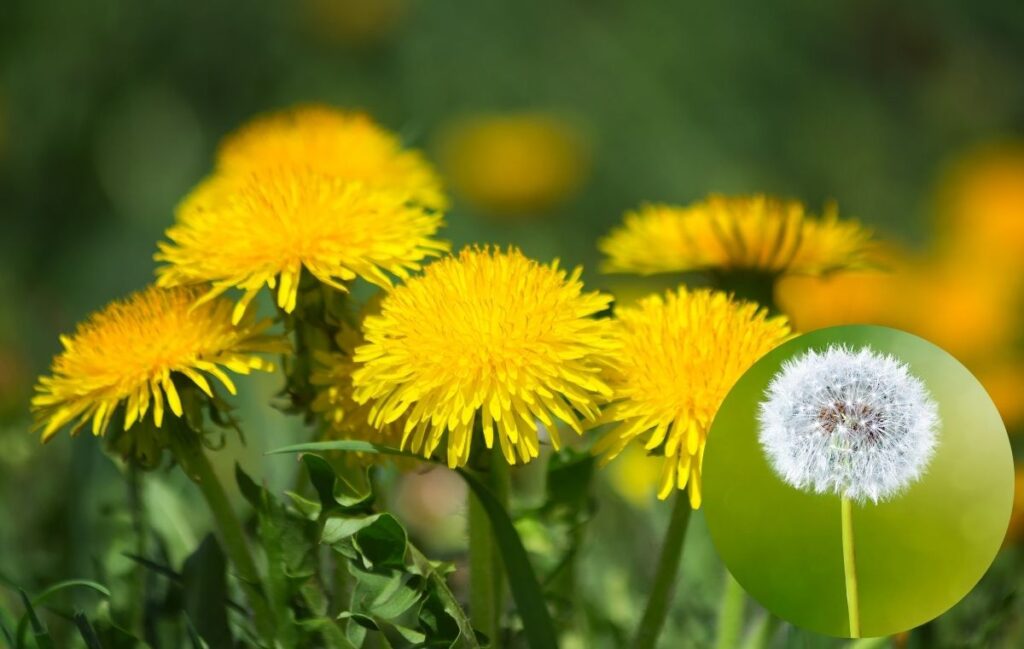
Lesser Celandine (Ficaria verna)
Herb in the buttercup family, it has bright yellow flowers like the buttercup and glossy dark heart-shaped petals. It is a perennial which means it can come back year on year if left untreated, if you choose to dig this weed be sure to be careful when picking out to avoid any seeds spreading and put in the garden waste bin rather than composting. Joe’s weed control can help take care of this weed.
Flowers between January and April
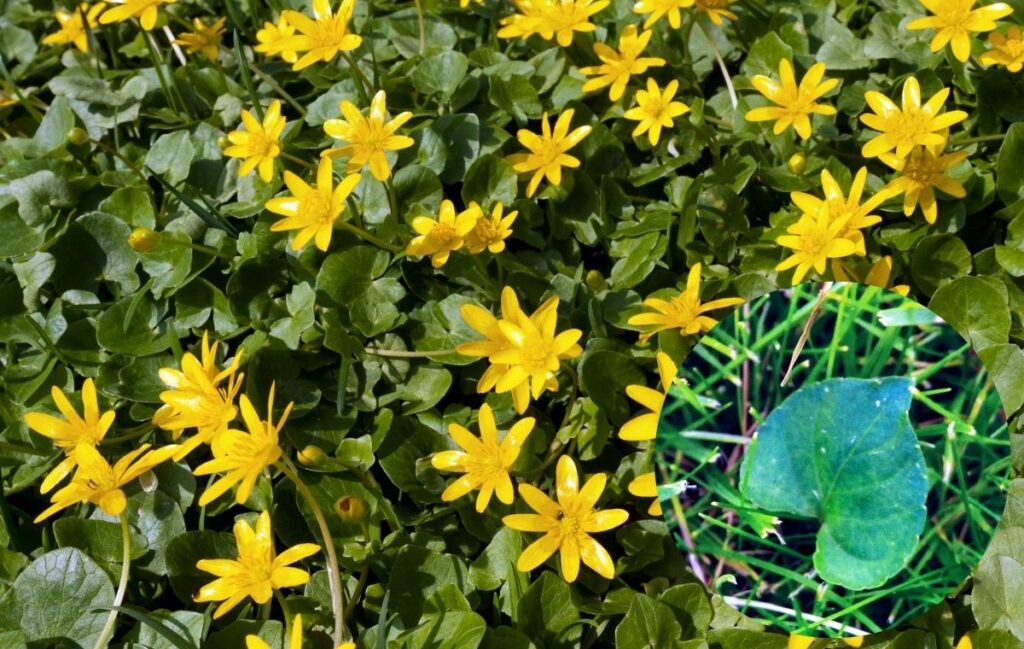
Mind-your-own-business (MYOB)
Mind-your-own-business (sometimes known as the equally odd “baby’s tears”) is a creeping perennial with tiny rounded leaves. Despite looking pretty in cracks in paving, it re-grows from the smallest stem sections and can soon get out of control. It is especially difficult to control on the lawn! MYOB forms dense, slowly spreading mats of bright green foliage. It bears minute white flowers in summer. The overall height is a mere 2inches but the spread is indefinite. This is a difficult plant to control, as it regenerates easily from any small sections of stem overlooked when weeding or hoeing. Often grass clippings that contain stem sections may survive the composting process, causing the weed to be further spread around the garden. Joe’s can take care of this for you before it becomes your business!
Ragwort (Senecio jacobaea)
Ragwort is a tall weed which can grow up to 90cm high, large flat clusters of yellow flowers similar to daisies. A single plant has thousands of seeds and they can be easily spread. Ragwort is mildly poisonous to humans, but can cause liver poisoning in horses and livestock. There are 19 different types and flowers from July through to October. It can be treated with weed control to help get rid of the weed, it can take up to 4 weeks to see any results, so patience is required.
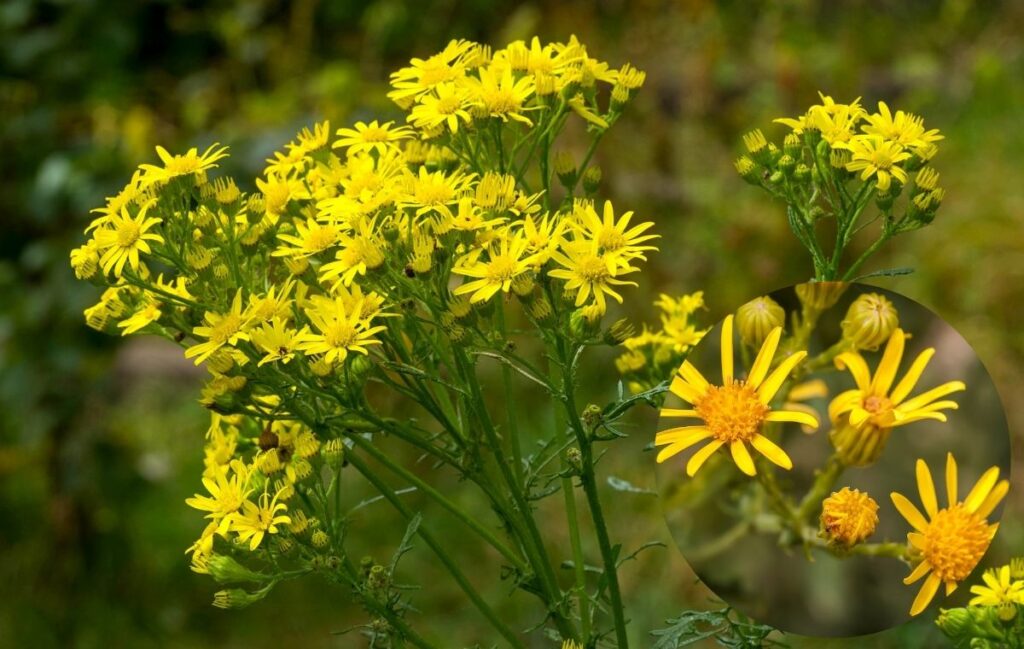
Ribwort Plantain (Plantago lanceolata)
A grassland plant, found in lawns, on tracks, at the edges of fields and roadside. The seeds have their own ‘gel’ retaining water, therefore being a superior weed and can grow in dry soils when other species can not. It will even sit in the soil for months or years waiting for the perfect conditions to come. When it grows it has oval flower heads shaped like an egg producing white stamens balancing on their thin stems and the leaves are shaped like spears and grow long (up to 25cm).
Flowers: April to October
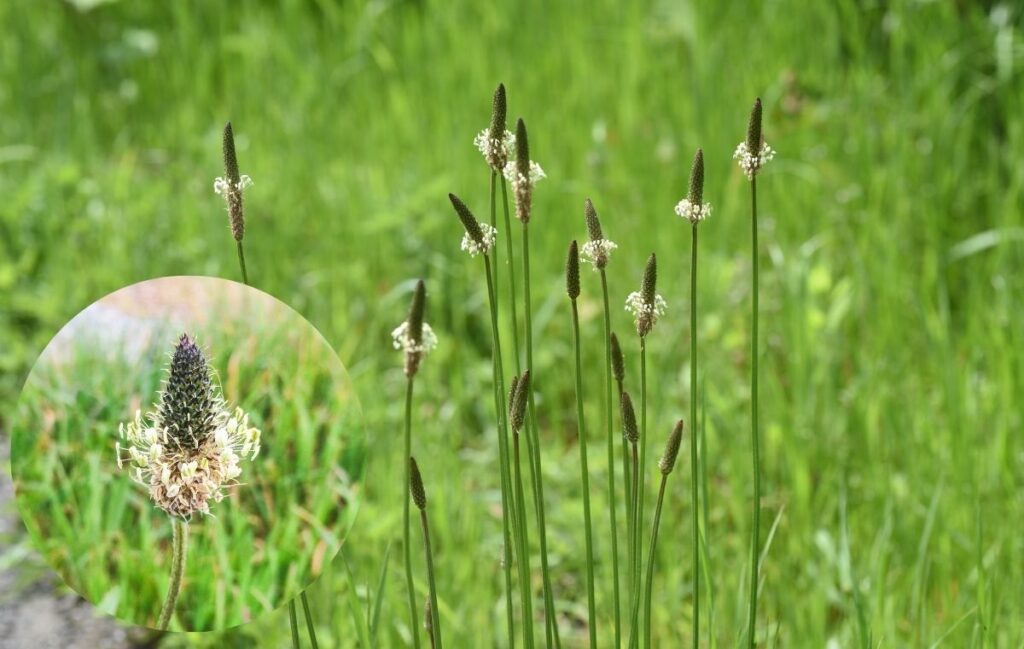
Selfheal
Selfheal is a member of the mint family and is a common weed on all types of lawns throughout the UK. It can be found on all types of lawns and will tolerate both dry and moist soils. This perennial weed spreads by creeping runners which root at intervals and as such it can quite happily grow and enjoy life in closely mown areas of turf. Selfheal leaves come in oval-shaped pairs and can have a smooth or slightly hairy surface. In areas where the turf is closely mown the leaves can have a purple tinge to them. Selfheal flowers purple from June to October, and again have a pair of leaves underneath them.
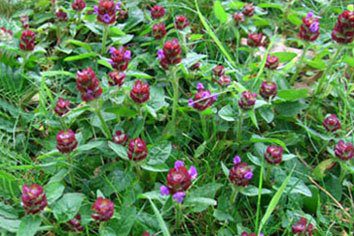
Regular mowing will help suppress seed head production. Like most weeds, Selfheal can be prevented by maintaining a strong healthy grass cover throughout your lawn. Selfheal is often an easy weed to control and for a widespread problem, one of Joe’s selective products will take care of it in 1 or 2 treatments.
Speedwell
Speedwell can survive in all soil types but it particularly enjoys moist, nutrient-rich soils and can tolerate low mowing. It is important to remove clippings whilst mowing the lawn, failure to do so helps this weed to spread. Scarification may prove beneficial in reducing numbers, however, if the infestation is more widespread a chemical weed killer will be needed for treatment. Speedwell is a difficult weed to control. Joe’s range of professional herbicides will always be more effective than those available for amateur gardeners.
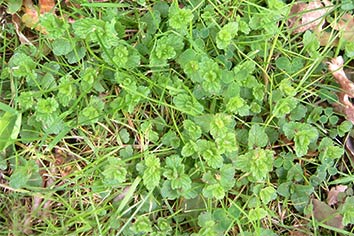
White Clover
Arguably one of the most common British garden weeds, found in grassy areas (lawns), again a tricky one to remove and can adapt to close mowing and not only that but it is a perennial, so will come back year on year. Clover can be a sign that your lawn is lacking nitrogen, therefore you need the Joe’s team to come in and treat it right away!
Flowers: May to October and can be white or pink in colour.
Yarrow
Yarrow, also known as ‘Milfoil’, is a perennial weed common on all types of lawns in the UK, however, it particularly thrives in nutrient deficient, dry and sandy soils. Yarrow is often an indicator that your lawn is suffering from a lack of nutrition! Yarrow leaves have a fern-like feathery appearance and give off a fragrance if rubbed or crushed. If present, small white flowers can be visible from June to October. It has deep fibrous roots to withstand extremely dry conditions and it spreads by creeping stems which root at intervals.

Regular mowing will help prevent Yarrow from flowering and producing seed. Keeping the lawn in a healthy condition by increasing the soil fertility will help suppress Yarrow. For a large infestation of Yarrow, a selective herbicide will have to be used to eradicate this weed and more than one application will be needed for successful control. Joe’s range of professional products will be more effective against Yarrow than amateur retail products.
Of all the problems associated with lawns and turf, moss is probably the most common and frustrating
Year after year many people treat, kill and remove moss from their lawns only to see it return again. Unless you correct the underlying conditions that cause this problem it will keep returning. Moss can be tackled in a variety of ways. One of the more effective methods is through Scarification where the cause of the moss is addressed by removing the surface thatch on which the moss is growing. Check out our SCARIFICATION page for more details.
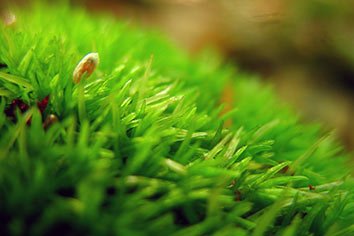
The bane of gardeners’ lives up and down the country! To effectively control moss it is essential to find the causes and correct them. The following conditions can cause moss:
- Poor surface drainage – A wet or damp lawn surface encourages fern and tufted type mosses
- An infertile lawn – Any lawn deficient in essential nutrients is prone to having a weak and thin coverage of grass, leaving it open for moss invasion
- Mowing the lawn too short – Mowing the grass too short causes the grass to become weak and inviting moss to invade. (see our mowing advice section of ‘Ask Joe’ for more information)
- Too much shade – Shaded lawns suffer from frequent moss problems due to the lack of sunlight resulting in a thin sward
- Drought – During dry summers it is important to irrigate to avoid any loss of grass resulting in a thin sward
- Acidic conditions – Moss prefers acidic conditions

Some of these conditions above are easily rectified as they are simply caused by poor practices. However, some of them can take more time to correct as they are problems within your soil or lawn. Nevertheless, with the correct treatment program from Joe’s, you will be able to gradually reduce any moss problems on your lawn. Although moss can be a problem at any time, it causes the biggest headache throughout the winter months and early springtime when the lawn is wettest and most shaded. Once your moss has been removed you may be left with some thin or bare areas. These areas should be OverSeeded to aid recovery. Don’t worry too much about this as Joe’s lawn treatment programmes contain a feed to help speed up recovery!
Unfortunately, your lawn is like many other garden plants and is just as prone to getting its fair share of unwanted pests & diseases.
Pests such as Leatherjackets and Chafer Grubs can cause untold damage to lawns whilst several diseases can leave your lawn requiring serious renovation and repair. Joe’s can help!
Keep scrolling down the page to learn more about the pests & diseases that affect your lawn. If you think your lawn may be infested just Ask Joe!
Ant Control
Ant hills can disfigure lawns they usually appear in summer and are especially prevalent in damp conditions. They can be dispersed by brushing the soil when conditions are dry. Most ant species build underground nests. Worker ants dig tunnels and chambers in the soil and as the colony grows, workers add more tunnels and chambers to the nest. As such, over time if left untreated the lawn may become uneven. Ants can also damage roots which may cause yellowing of the grass
Ant colonies can grow to be quite large:
- Their nests may reach 6 meters below the ground
- A group of nests may cover an area as large as a tennis court
- Millions of ants may live in these nests
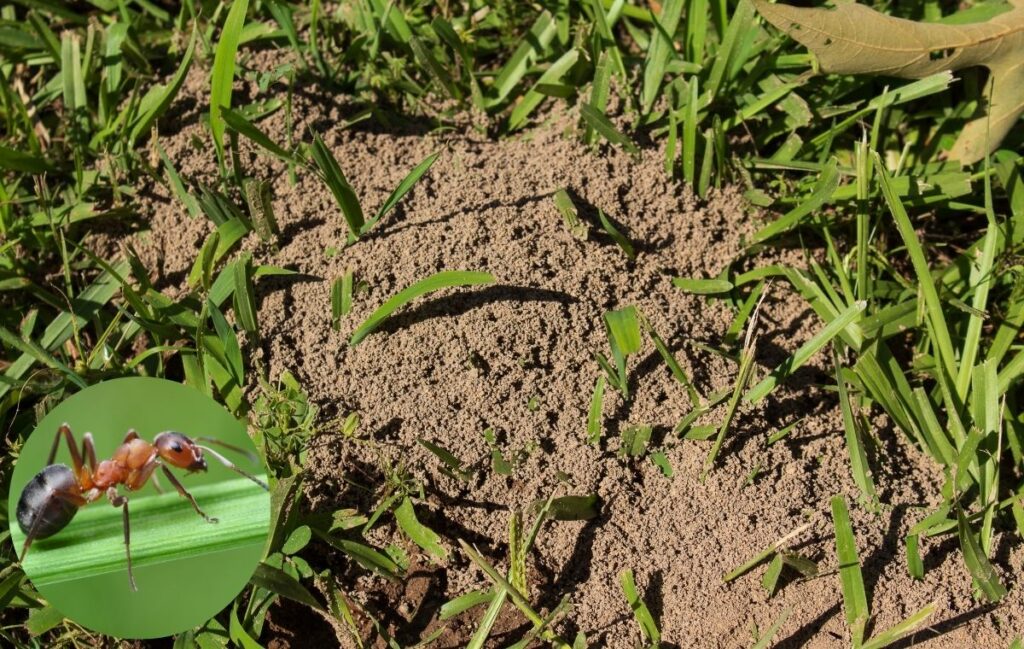
Whilst we are at it, here are some further interesting Ant Facts:
- There are more than 12,000 species of ants all over the world
- An ant can lift 20 times its own body weight
- Some queen ants can live for many years and have millions of babies!
- Ants don’t have ears. Ants “hear” by feeling vibrations in the ground through their feet
- When foraging, ants leave a pheromone trail so that they know where they’ve been
- Queen ants have wings, which they shed when they start a new nest
- There are more than 12,000 species of ants all over the world
- When the queen of the colony dies, the colony can only survive a few months.
Chafer Grubs
The Chafer Grub is the larvae of the May Bug and will again cause widespread damage to lawns. In some cases, the roots of a lawn can be so seriously damaged that the turf can be rolled up like a carpet.
Other than the appearance and health of the turf deteriorating, a good indication of the existence of both leatherjackets and chafer grubs is the congregating of birds on the lawn, digging into the turf to feed on the pests. Unfortunately, this is not a satisfactory control method!
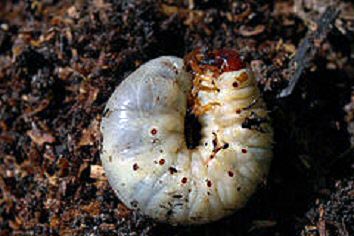
Leatherjackets
Recently in Britain, we have enjoyed long warm summers and warmer than average winters. (Who’s complaining?!) These mild winters have resulted in an explosion in the population of Daddy Longlegs. These flies lay their eggs in grassed areas – usually lawns. Over the winter and spring period, the eggs hatch, and the resultant larvae, called Leatherjackets, feed off the roots and young shoots of the lawn. This can have a devastating effect on a lawn. Leatherjackets are legless, brown/grey in colour and can grow up to 4cm long. Normally, a prolonged hard frost will control the number of these lawn pests, but recent mild winters have caused their number to increase dramatically!
Worms
Worms are good for the lawn, they are a natural aerator, allowing the soil breathing room. They can however cause casts on the lawn’s surface, these need brushing before mowing as they will cause the soil to become a compact mound which will be harder to get rid of.
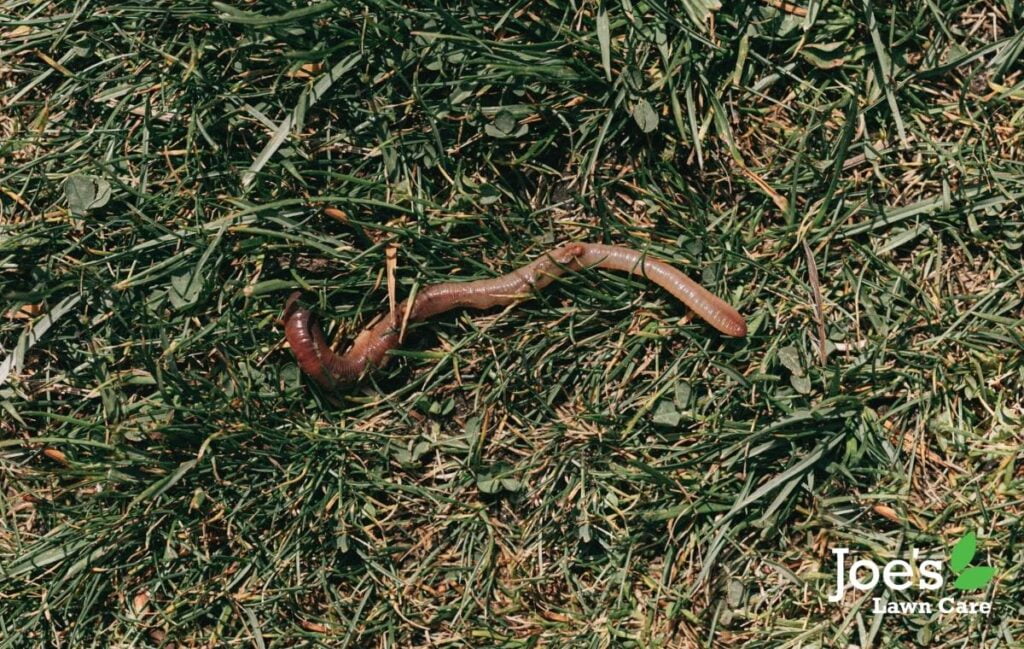
Diseases
Dry Patch
Mycelium fungus, related to ‘fairy rings’ disease. This lawn disease can be fatal, it will turn areas of the grass brown because the soil has dried out and is unable to absorb enough moisture to keep the grass plant healthy. It is unknown what the real cause of Dry Patch is, we do know that the fungi release chemicals into the lawn as it grows and it is these chemicals that repel the water from the soil.
Potential reasons it could happen: Thick level of thatch and/or sandy soils.
It is important to check the problem in multiple areas on the lawn, can it be saved? To help your lawn get back to good health we need to see if it is controllable with wetting agents and fungicides. If in extreme cases and it is a large spread you will be able to see the fungi in the soil, and in these worst-case scenarios it is impossible to control the disease and we would recommend a full lawn renovation including removal of soil.
Treat and Control:
- If your lawn hasn’t suffered too badly with it we recommend you try to treat yourself before getting the experts in. (Mix: 1-2 tablespoons of fairy liquid with water in a watering can).
- Identify the areas, do soil tests in multiple locations on the lawn
- Aerate, passing numerous times to create a pocket for treatments and moisture to get into.
- Get Joe’s to apply the fungicide and wetting agent. This is not a one-off treatment and will need to see you a few times.
- Scarify to remove thatch- apply top dressing and overseed the bare patches.
If these don’t work after a year or so your only option is to replace the whole lawn and the soil underneath.
Fairy Rings
A fungal colony that can cause a circular ring of dead grass and/or toadstools to appear. Mycelium (the fungus) spread beneath the grass surface and lives amongst the grass roots, feeding on thatch and tree stumps creating the circular ring.
Unfortunately, there is no permanent cure for lawn diseases, however there are fungicides that can helptreat and prevent. There is no fungicide readily available to the public, there is a strict legislation controlling the application of professional products for domestic use. Be sure to use a lawn company that is BASIS lawn assured, like Joe’s :-).
Fusarium
Fusarium, sometimes called snow mould, is a common cause of brown patches on lawns, particularly in Autumn or during mild Winter spells. The disease is sometimes very noticeable after thaws of snow, when it is given the common name of snow mould.
Fusarium is one of the most damaging diseases for turf grasses and can be difficult to control. The disease is first noticed as small patches of yellowish dying grass that later turn brown, increase in size and often merge together.
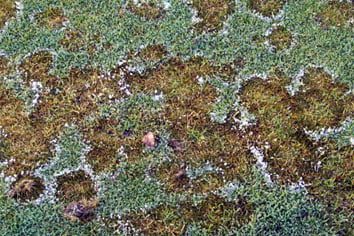
Improved drainage can help keep Fusarium at bay by ensuring that the lawn dries rapidly after dews or rainfall. This can be done by a combination of Scarifying and Aeration. (Check out these sections for more information on what these processes involve.) We also have a guide on how to deal with Fusarium, check it out here.
Red Thread
Red Thread can leave patches of turf in a ‘straw-like’ brown condition, which gives the entire lawn an all-over mottled effect, which looks unsightly.
This disease is often seen on lawns in the UK from mid-Summer through to Autumn time and it can develop on all lawn types. It is a fairly minor disease that in most cases does relatively little damage, but can drastically spoil the appearance of a lawn. It is spread by spores within the air.
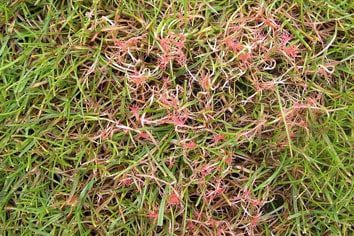
Studied closely you may be able to see red needles or pink ‘cotton-wool’ like growth on the affected areas. This is the manifestation of the fungus. More often than not, the disease will run its course and as the turf grows the disease becomes less obvious.
On many occasions, an application of Joe’s fertiliser is more than sufficient to promote lawn growth.
Slime Mould
A more common name is dog vomit fungus.
The spore producing structures can show up quite quickly, sometimes as fast as overnight. A depletion of nutrients is a common trigger (very common in hot summers).
The spore-producing structures may develop throughout the year, but are found most commonly in late summer and autumn. You’ll be pleased to know it does not attack the plant and no control is required, it can quickly go as easily as it came. If really unsightly you can jet wash the area to remove the spores.
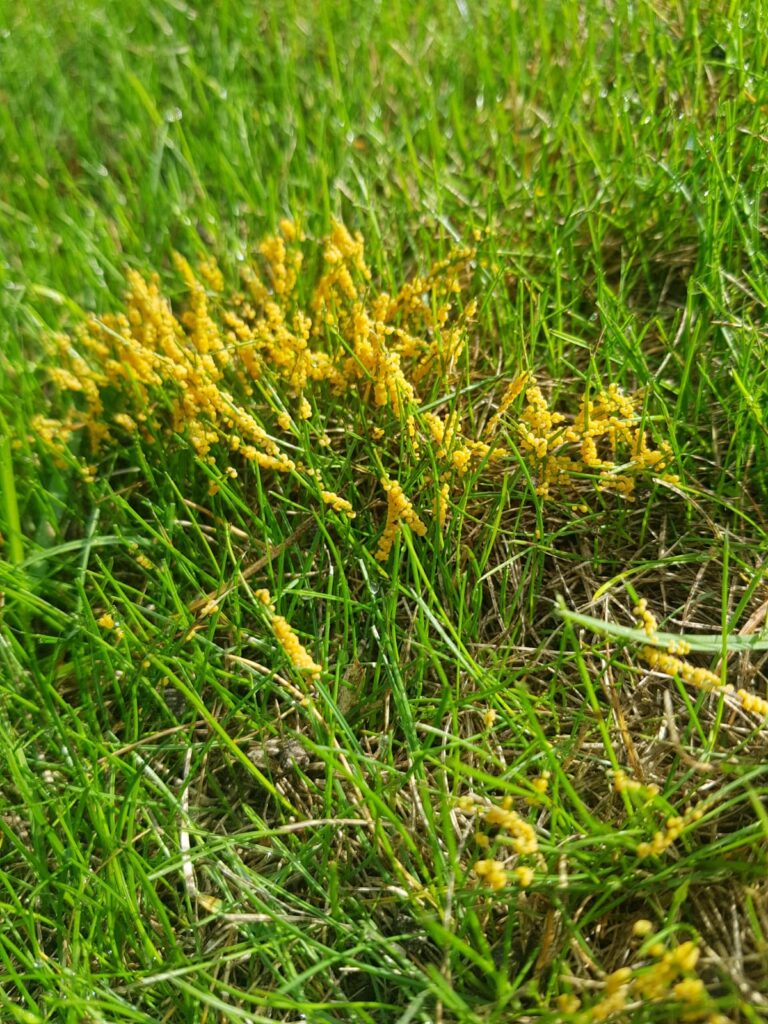
Sooty Mould
A fungal disease caused by a number of different fungi. This doesn’t directly attack the grass plant which it is growing on, but the presence of the fungus on the leaves blocks out the sunlight and can reduce the growth of the plant.
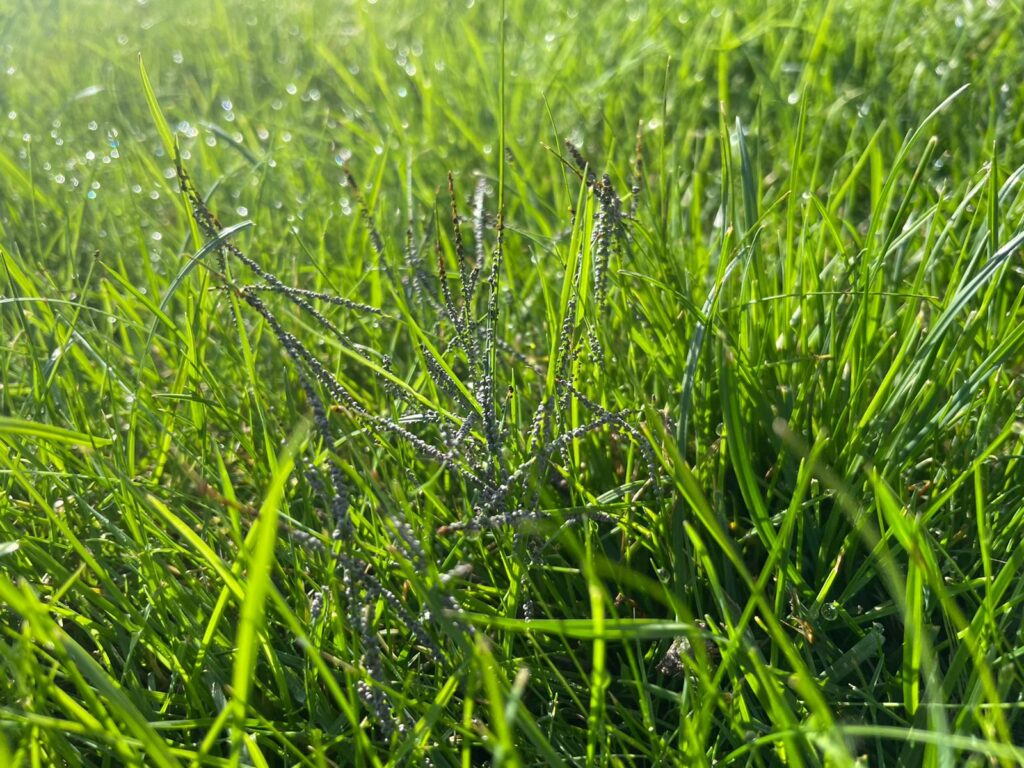
Lichens
Lichens are neither plant nor fungus but a combination of both. They are very unattractive and generally will only live on patios, driveways, paths, garden furniture and fencing. They can be treated with a hard surface cleaning treatment from Joe’s.
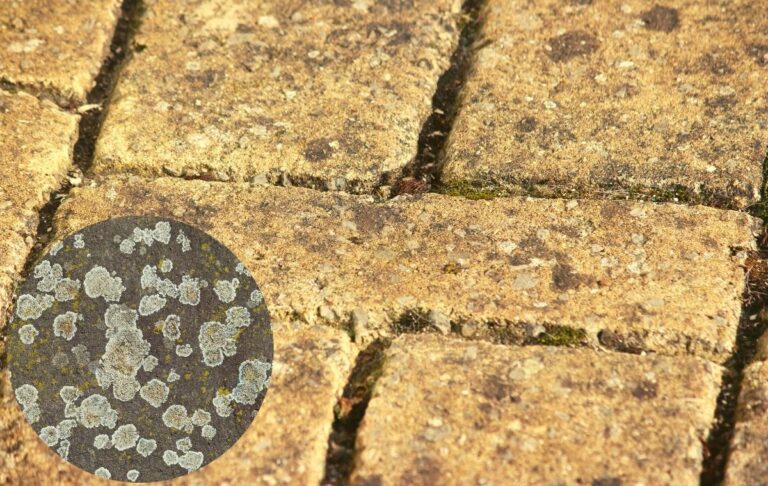
Fungi, Toadstools and Mushrooms
We know they look better in a chicken pie but the mushrooms on your lawn are a good sign of a healthy lawn. They will usually appear in warm, humid conditions and likely disappear after a few weeks or when weather conditions change. They don’t have a root system as such, so they won’t affect the grass by competing for nutrients.
So why are they good I hear you ask…
- You pick them off close to the base (wear gloves)
- Mow short with a mower which collects grass in order to stop them from spreading
Or read our blog about why and how you should remove shrooms
However please note, if they do start to make circles in the lawn, known as fairy rings these can be a problem and you will need expert advice on how to treat them.
To prevent mushrooms from growing then you must monitor the conditions of your lawn regularly, scarifying will help as it will remove a layer of thatch.
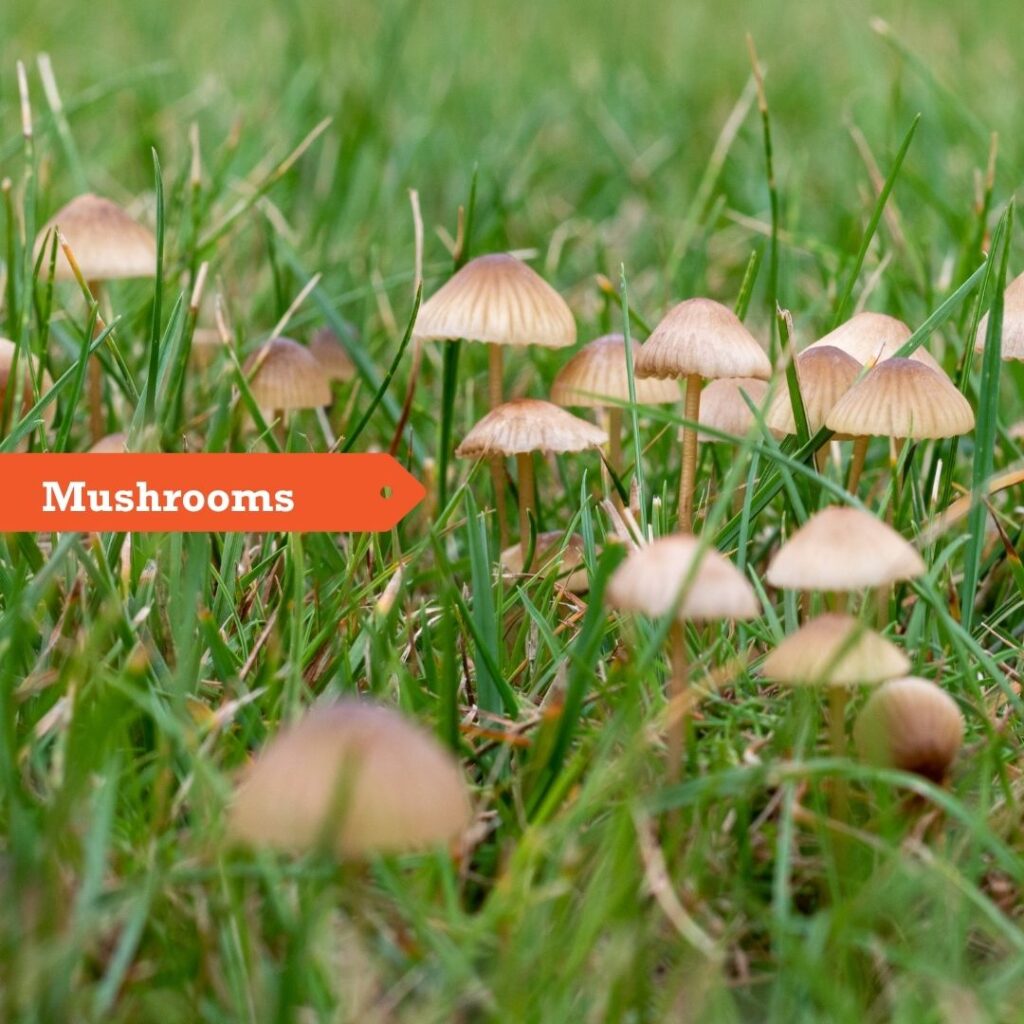
White Spindles
White Spindles or ‘Fairy Fingers’ are an uncommon species of fungus. Found throughout Britain and Ireland. It is often associated with older lawns which haven’t been reseeded or treated with fertilisers and moss-killers.
Due to the small height of the spindles, this fungus can be overlooked. Once the ‘Fairy Fingers’ have finished flowering, they usually disappear, they have no long-term damage to your lawn. In fact, it means that your lawn contains healthy nutrients for this fungus fruiting species!
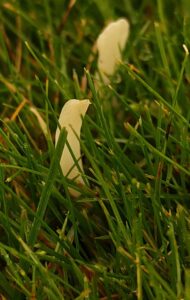

Thatch is a layer in between the grass on your lawn and the soil/root system below, it is composed of dead grass and other components.
Thatch is a common problem that forms over time. The thicker the layer, the more it can suffocate your soil from getting the water, air and nutrients it needs. It can also welcome diseases and insects to your lawn, so it is important to remove the layer of thatch or at least most of it.
Forming a spongy layer on your turf, thatch makes it difficult to mow properly. Thatch causes the grass to grow unevenly and the spongy texture means that the wheels can sink into the ground, creating an uneven surface.
If the layer of thatch is thin, you can use a scarifying rake to minimise the problem. Fully removing a thick layer of thatch requires the use of an expensive scarifying and aerating machine. This is something you can buy yourself, or you can hire a professional lawn care hero (like us!) to do it for you.
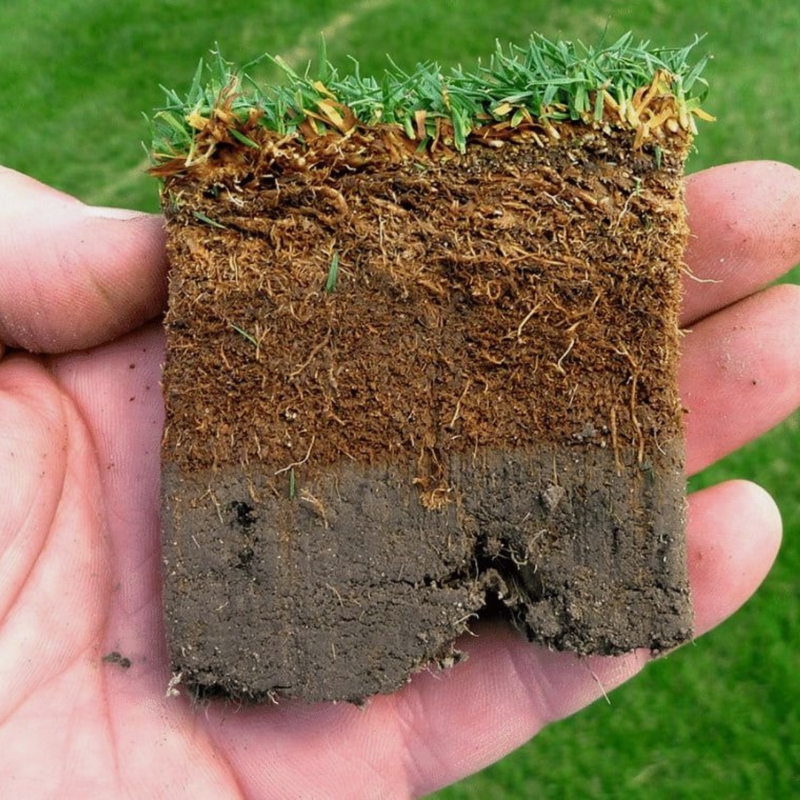
For more information on any of these treatments just check out the relevant page or Ask Joe!





